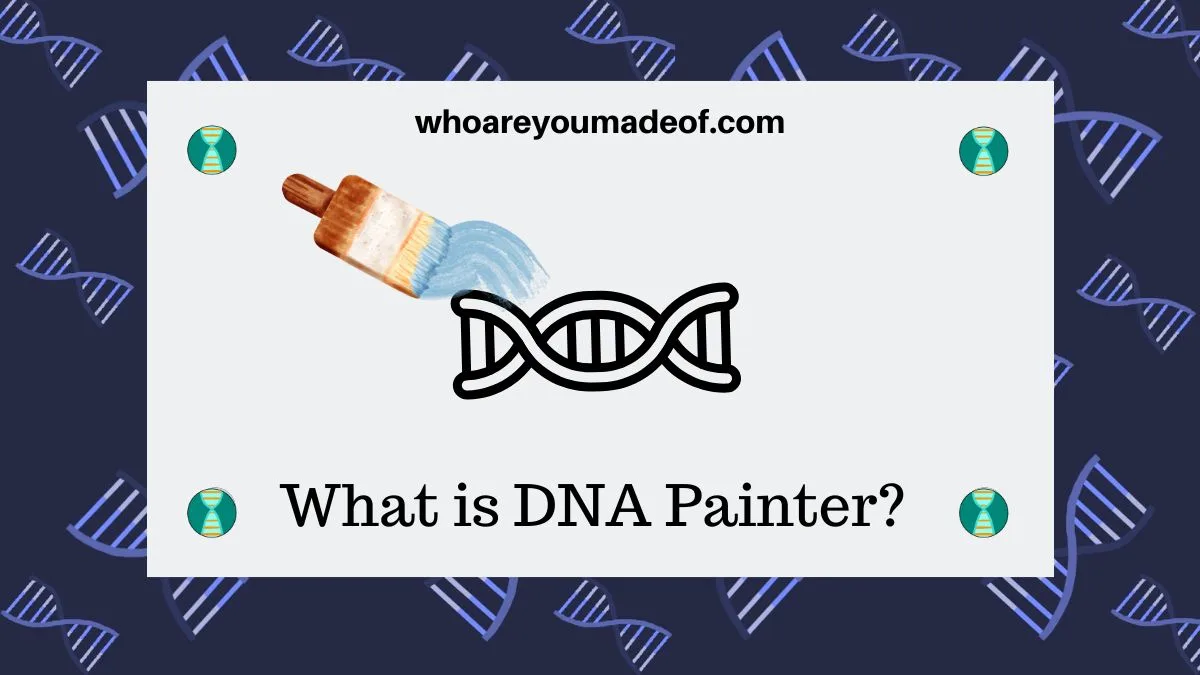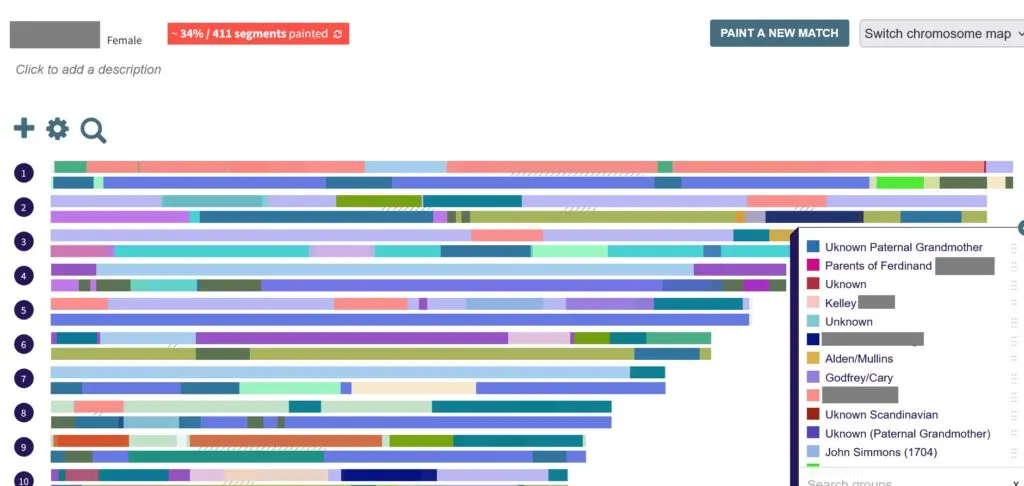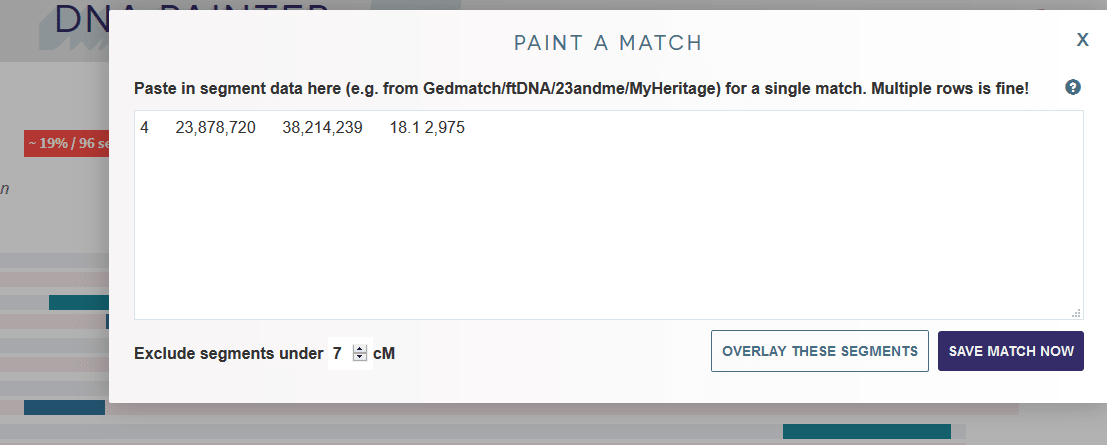Have you heard of DNA Painter, but you don't know what it is? In this post, learn the basics about this fun and useful site that helps us better understand our DNA matches.
I'm a huge fan of painting my DNA matches. When the tool first came out several years ago, I knew it would help take my research to the next level.

DNA Painter is a user-friendly website that offers a variety of DNA analysis tools. Most of the tools are available to use for free, though there is a subscription available that allows for more functionality for advanced users.
My favorite tool on the DNA Painter website is a tool that uses chromosome mapping technique called "chromosome painting" to help users track and visualize exactly which DNA segments on each chromosome can be attributed to specific ancestors.
This is done through examining and "mapping" exactly which DNA segments are shared with DNA matches to whom you have already determined your relationship and shared ancestor.
Once you have a good understanding of where all of your ancestors lie on your chromosomes, you can then use this information to easily determine how other DNA matches are related to you based on the segments that you share.
The concept of DNA Painter might sound really complicated and technical, but I promise you that it is not. In this post, I'll explain a little bit more about what it actually does, answer a few common questions, and give you some ideas about how you can use it for your research.
Note: Ancestry DNA users will need to upload their DNA to other sites in order to have access to detailed chromosome data to be able to use DNA Painter. It's worth the effort, I promise.
What is chromosome or DNA painting?
We all have 22 numbered chromosomes, and we get one copy of each numbered chromosome from each of our parents. Simply explained, our chromosomes contain DNA segments that we got from our parents, large and small, which our parents inherited from their ancestors.
In genetic genealogy, we use the term "chromosome painting" to describe "painting" each chromosome with a different color that corresponds to a DNA segment inherited by a particular ancestor. It's a great way to visualize your DNA segments.
When we know how we are related to a DNA match, such as might be the case with a known full second cousin on your father's side of the family on your DNA match list, we know that the DNA segments shared between you and your second cousin were inherited one of your sets of great-grandparents.
If we "paint" this second cousin match into DNA Painter, we are essentially marking those locations on your chromosomes as having been passed down to you from those two great-grandparents that you share with your second cousin. This is helpful because we now know that if any other paternal DNA match also shares those DNA segments with you, they are related to you through your great-grandparents.
Don't worry if you don't consider yourself creative - DNA Painter paints your segments automatically based on information that you copy and paste into the site. You can choose the colors, or the site can choose them automatically.
And since we are not trying to create a work of art, those of us who are artistically challenged (me!) have no need to worry. The visualization comes together on its own as we "paint" our matches.
Super simple!
As an example, I want to show you my profile in DNA Painter as it currently looks today. You can see from the image below that about 34% my chromosomes have been "painted" - meaning that I have identified which ancestor I inherited those segments from.
This adds up to about 411 individual DNA segments that I inherited from many different ancestors.
Even with just 34% of my segments painted, I can already easily isolate how I am related to many of my DNA matches. (See example below). As you can see, I still have a lot more painting to do!

What can you do with DNA Painter?
As I mentioned above, the idea is that you "paint" individual DNA segments onto the paternal or maternal copy of a particular chromosome.
Once you have a particular segment painted, you then know that if you match someone else on your paternal or maternal side on that same chromosome in the same location, then you are related to that match through the same line of your family.
See the image below as an example. I was able to determine that a DNA match is related to me through my Ellsworth line, which is on my dad's side of the family. I easily copied and pasted the information from Gedmatch One-to-One results comparing my kit with my match's kit, and the segment was automatically "painted":

When you click on the little orange/brown segment, it shows that the start and end location for that segment on that chromosome was inherited from my Ellsworth ancestor and his wife.
If I get a new match that matches me at that same location on that same chromosome from my dad's side of the family, I can be sure that my new match is either descended from that Ellsworth ancestor, or a previous Ellsworth ancestor.
Once I get more matches painted in, it can help me feel more confident about my assumptions about segments. I'll also be able to easily view groups of matches all sharing the same segment with me - basically, triangulation groups.
Basically, it can help me know where to focus my efforts to find the exact connection.
Does DNA Painter store your DNA data?
Your DNA information or file is not stored on DNA Painter. In fact, you never upload your DNA file or any other file that contains sensitive information, unless you choose to upload your family tree to the site.
All of the information stored on the site is entered by you and only contains the data that you enter in relation to particular DNA segments. This can include ethnicity data corresponding to specific DNA segments, if you are a 23andMe user and have uploaded your ethnicity segment data to the site.
How does DNA Painter work?
In order to use DNA Painter, the first step is to create a profile, which will generally be of the person who took the DNA test. I have profiles for myself, my mother, my father, and my paternal grandmother.
Once you have created profiles, you then choose a relatively close cousin match to "paint" into your profile. It's best if you already know which side of the family a few cousins match you on to help you figure out which copies of your chromosomes are paternal and maternal.
You just copy and paste the information into the "paint" tool (in the image below, the information was copied and pasted from Gedmatch):

How much does DNA Painter cost?
It is free to create a DNA Painter account and one profile for chromosome painting. While there are many functions and features of the site that you can use for free, there is an annual subscription available for about $55 that allows access to additional tools and functionality.
I highly recommend taking advantage of this very easy-to-use DNA analysis tool, whether you use the free or paid version of the site.
It's much more efficient than scrolling through family trees, looking for surnames, and eventually getting lost in the various branches. After you learn how to use the tool and paint in a portion of your chromosome, you will find that it makes discovering how you are related to your matches much easier.
Conclusion
I hope that this post gave you a quick overview of DNA Painter as a tool for painting your DNA segments on your chromosomes. If you are interested in a more complete "how-to" tutorial, you can click on the post below:
If you have any questions, comments, or would like to share your experience with DNA Painter, I would love to hear from you below.
Thank you for stopping by!


Andre
Tuesday 11th of July 2023
Hello, do you share your information on You Tube or Facebook?
David Hemmings
Monday 13th of June 2022
Hi Mercedes, I appreciate all the work you do. Thank you. I am a "longtime" genetic genealogist and have now completed the discovery of birth parents for 20 adoptees. The latest, however, is more difficult. I have yet to receive the adoption papers on one adoptee (pandemic delays) but through DNA triangulation I have found the surnames of both grandmothers (assuming the grandfathers' surnames match the parental surnames!). Being all in Ireland the documentation is sparce or unavailable. This adoptee has no DNA relative closer than 2nd cousin, and we are not certain that the birth parent names we received at an earlier interaction with the adoption authorities are correct (maybe possible untruths were told at the birth interview). So the names of the birth grandfathers remain uncertain. Which way would you recommend I proceed to decide which grandmother is on the birth mother's side and which on the birth father's side? Thank you, David
Alexandra ME Cloud
Sunday 15th of November 2020
Hi Mercedes Just to say how much I like your posts, and that a follow-up “how-to” for DNA painter would be great ? definitely interested! All the best